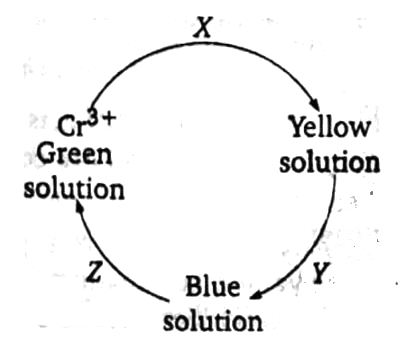The electron affinity values (in kJmol−1 ) of three halogens, X, Y
and Z are respectively -349, -333 and -325. Then X, Y and Z are respectively
F,Cl,Br
Cl,F,Br
Cl,Br,F
Br,Cl,F
The correct Answer is:B
To determine which halogens correspond to the given electron affinity values of -349 kJ/mol, -333 kJ/mol, and -325 kJ/mol, we can follow these steps:
Step 1: Understand Electron Affinity
Electron affinity is the amount of energy released when an electron is added to a neutral atom in the gas phase. The more negative the value, the more energy is released, indicating a stronger attraction for the added electron.
Step 2: Identify the Halogens
The halogens in Group 17 of the periodic table include:
- Fluorine (F)
- Chlorine (Cl)
- Bromine (Br)
- Iodine (I)
Step 3: Order of Electron Affinity
Generally, the electron affinity of halogens decreases as we move down the group:
- Fluorine (F) has the highest (most negative) electron affinity.
- Chlorine (Cl) has a slightly lower (less negative) electron affinity than fluorine.
- Bromine (Br) has an even lower (less negative) electron affinity than chlorine.
- Iodine (I) has the least negative electron affinity among the common halogens.
Step 4: Compare Given Values
Now, we compare the given electron affinity values with the known trends:
- -349 kJ/mol
- -333 kJ/mol
- -325 kJ/mol
From the general trend:
- The most negative value (-349 kJ/mol) corresponds to Chlorine (Cl).
- The next value (-333 kJ/mol) corresponds to Fluorine (F).
- The least negative value (-325 kJ/mol) corresponds to Bromine (Br).
Step 5: Assign Halogens to Values
Based on the above analysis:
- X = Chlorine (Cl) with an electron affinity of -349 kJ/mol
- Y = Fluorine (F) with an electron affinity of -333 kJ/mol
- Z = Bromine (Br) with an electron affinity of -325 kJ/mol
Conclusion
Thus, the halogens X, Y, and Z are:
- X = Cl
- Y = F
- Z = Br
Final Answer
X = Cl, Y = F, Z = Br
---
Electron affinity is the amount of energy released when an electron is added to a neutral atom in the gas phase. The more negative the value, the more energy is released, indicating a stronger attraction for the added electron.
The halogens in Group 17 of the periodic table include:
- Fluorine (F)
- Chlorine (Cl)
- Bromine (Br)
- Iodine (I)
Generally, the electron affinity of halogens decreases as we move down the group:
- Fluorine (F) has the highest (most negative) electron affinity.
- Chlorine (Cl) has a slightly lower (less negative) electron affinity than fluorine.
- Bromine (Br) has an even lower (less negative) electron affinity than chlorine.
- Iodine (I) has the least negative electron affinity among the common halogens.
Now, we compare the given electron affinity values with the known trends:
- -349 kJ/mol
- -333 kJ/mol
- -325 kJ/mol
- The most negative value (-349 kJ/mol) corresponds to Chlorine (Cl).
- The next value (-333 kJ/mol) corresponds to Fluorine (F).
- The least negative value (-325 kJ/mol) corresponds to Bromine (Br).
Based on the above analysis:
- X = Chlorine (Cl) with an electron affinity of -349 kJ/mol
- Y = Fluorine (F) with an electron affinity of -333 kJ/mol
- Z = Bromine (Br) with an electron affinity of -325 kJ/mol
Thus, the halogens X, Y, and Z are:
- X = Cl
- Y = F
- Z = Br
X = Cl, Y = F, Z = Br
Topper's Solved these Questions
- CHEMISTRY AT A GLANCEBOOK - ALLENCHAPTER - CHEMISTRY AT A GLANCEEXERCISE - ORGANIC CHEMISTRY
472 Videos
- CHEMISTRY AT A GLANCEBOOK - ALLENCHAPTER - CHEMISTRY AT A GLANCEEXERCISE - ORGANIC CHEMISTRY
472 Videos
- Chemical EquilibriumBOOK - ALLENCHAPTER - Chemical EquilibriumEXERCISE - All Questions
30 Videos
- ELECTROCHEMISTRYBOOK - ALLENCHAPTER - ELECTROCHEMISTRYEXERCISE - EXERCISE -05 [B]
38 Videos
Similar Questions
The electron affinity values(inKJmole−1) of three halogens x, y and z are respectively −349,−333and−325. Then x, y and z respectively are
View SolutionIn this sequence X, Y , Z are respectively:

View SolutionIn the following reaction X,Y and Z are respectively :

View Solution
The formed products Z,Y,X are respectively .
View SolutionThe CORRECT names at 'X' ,'Y' & 'Z' respectively are

View SolutionIn the carbylamine reaction, R−X converted R−Y via the intermediate Z,R−X,R−YandZ, respectively are
View SolutionThree elements X, Y and Z are in the 3rd periodic table. The oxides of X, Y and Z, respectively, are basic, amphoteric and acidic, The correct order of the atomic numbers of X, Y and Z is :
View SolutionWhich will have the maximum value of electron affinity Ox,Oy,Oz [x,y and z respectively are 0,−1 and −2]?
View SolutionIf the 4th, 10th and 16th terms of a G.P. are x,y and z respectively, then x,y,z are in
View SolutionA compound contains three elements X, Y and Z. The oxidation number of X, Y and Z are +3,+5and−2 respectively. The possible formula of the compound is
View Solution
